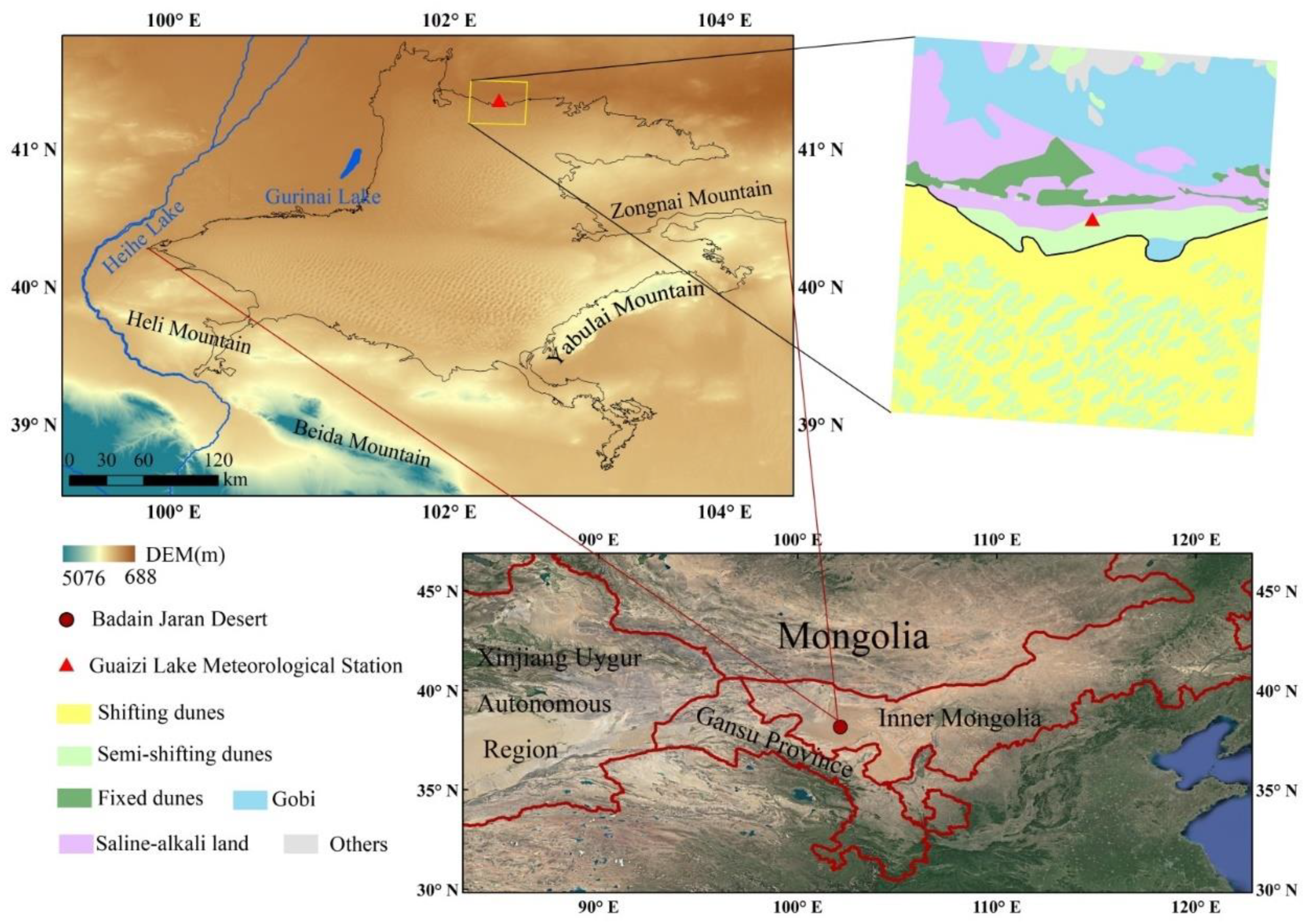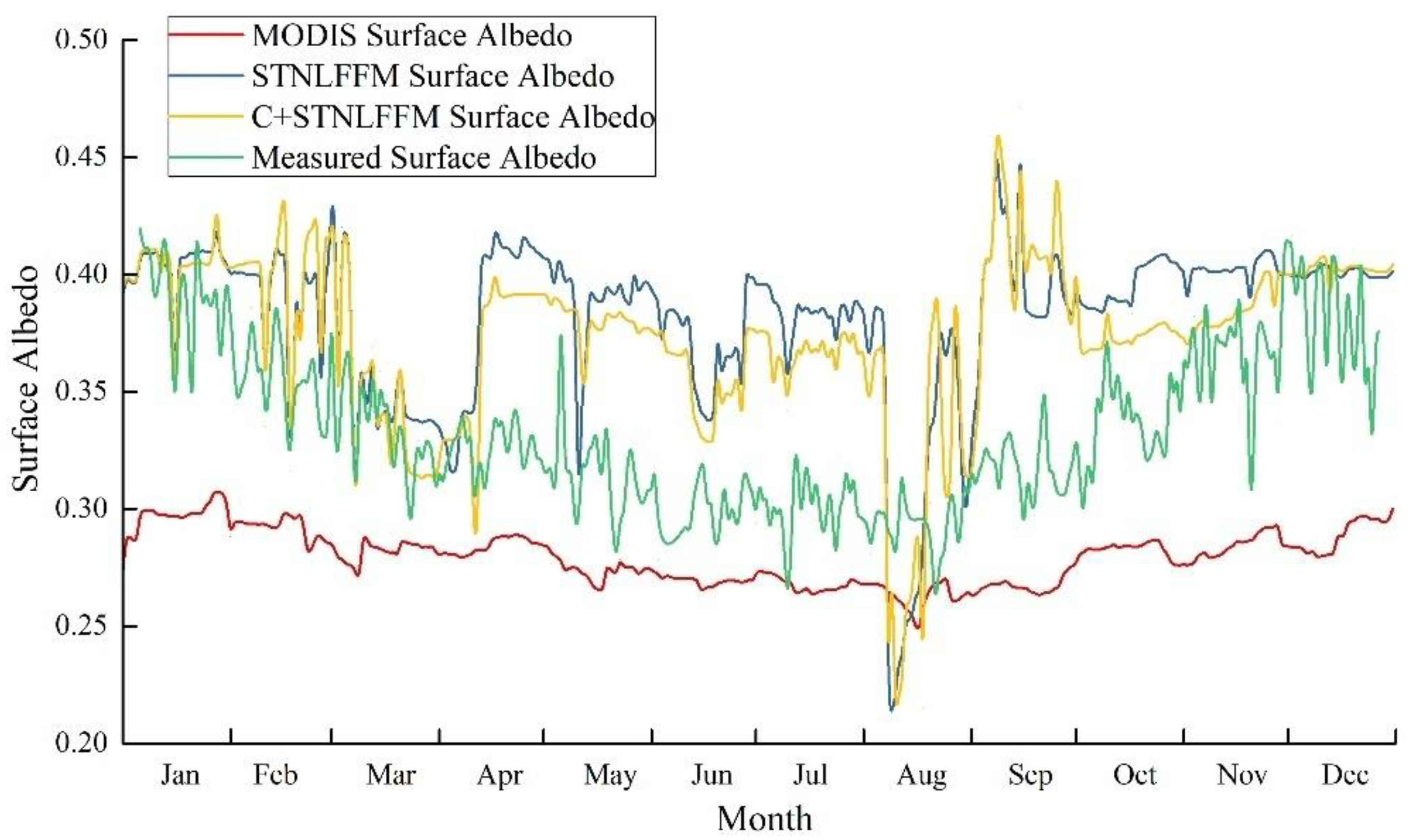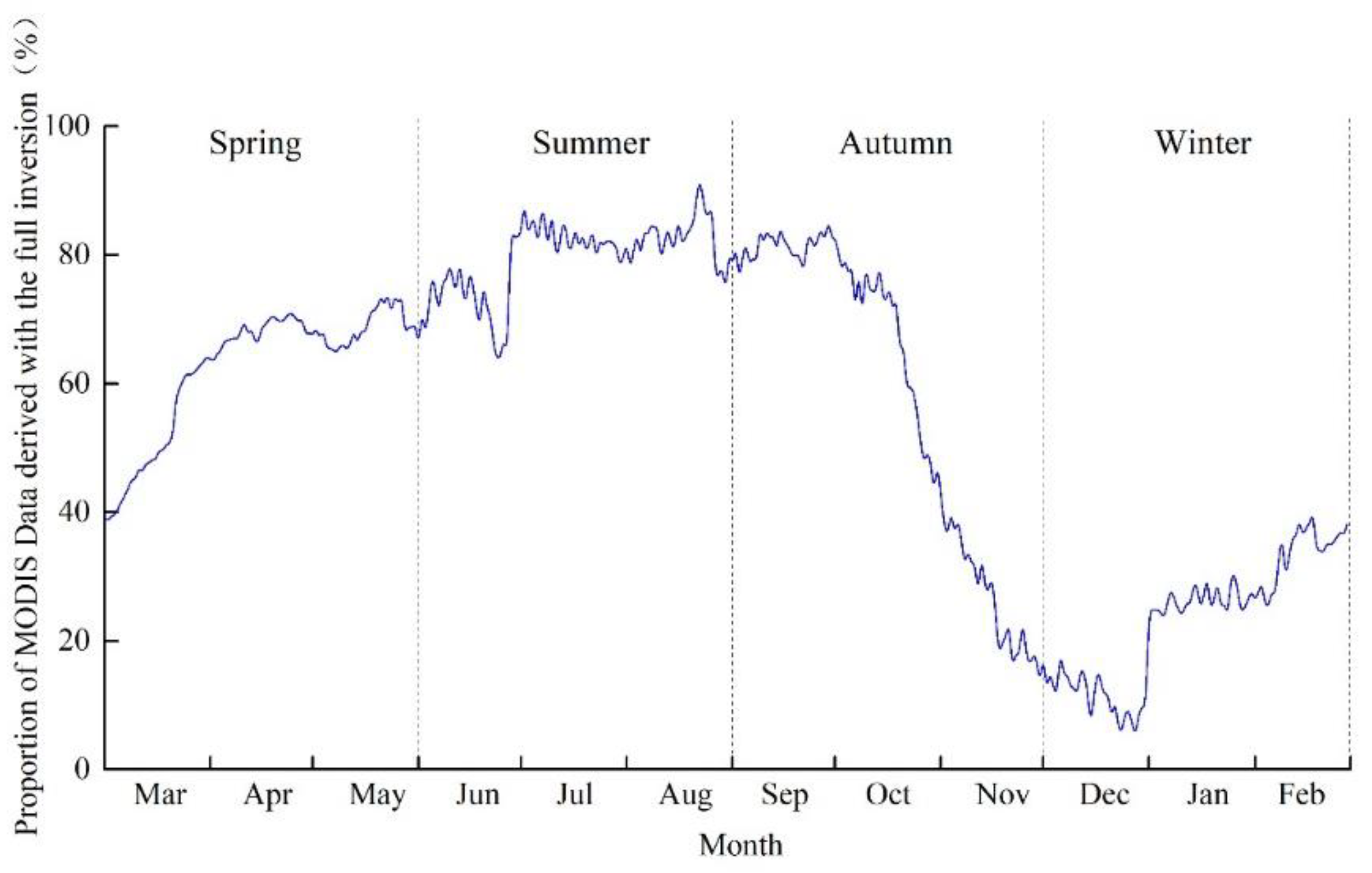Study on Spatial and Temporal Characteristics of Surface Albedo at the Northern Edge of the Badain Jaran Desert Based on C + STNLFFM Model
Abstract
:1. Introduction
2. Materials and Methodology
2.1. Study Area
2.2. Data
2.3. Analysis Method
2.3.1. C Correction Model
2.3.2. STNLFFM
3. Results
3.1. Accuracy Verification for STNLFFM-Based and C + STNLFFM-Based Spatiotemporally Fused Surface Algorithms
3.2. Differences in Spatiotemporal Distribution between STNLFFM-Based and C + STNLFFM-Based Fused Surface Albedo
4. Discussion
5. Conclusions
Author Contributions
Funding
Conflicts of Interest
References
- Niu, Z.; Wang, N.; Meng, N.; Liu, J.; Liang, X.; Cheng, H.; Wen, P.; Yu, X.; Zhang, W.; Liang, X. Contribution of Lake-Dune Patterning to the Dune Height of Mega-Dunes in the Badain Jaran Sand Sea, Northern China. Remote Sens. 2021, 13, 4915. [Google Scholar] [CrossRef]
- Yang, X.; Rost, K.T.; Lehmkuhl, F.; Zhenda, Z.; Dodson, J. The evolution of dry lands in northern China and in the Republic of Mongolia since the Last Glacial Maximum. Quat. Int. 2004, 118, 69–85. [Google Scholar] [CrossRef]
- Hu, W.; Wang, N.A.; Zhao, L.; Ning, K.; Zhang, X.; Sun, J. Surface energy and water vapor fluxes observed on a megadune in the Badain Jaran Desert, China. J. Arid Land 2015, 7, 579–589. [Google Scholar] [CrossRef]
- Facchini, M.C.; Mircea, M.; Fuzzi, S.; Charlson, R.J. Cloud albedo enhancement by surface-active organic solutes in growing droplets. Nature 1999, 401, 257–259. [Google Scholar] [CrossRef]
- Ryken, A.; Bearup, L.A.; Jefferson, J.L.; Constantine, P.; Maxwell, R.M. Sensitivity and model reduction of simulated snow processes: Contrasting observational and parameter uncertainty to improve prediction. Adv. Water Resour. 2020, 135, 473–488. [Google Scholar] [CrossRef]
- Charney, J.; Quirk, W.J.; Chow, S.H.; Kornfield, J. A comparative study of the effects of albedo change on drought in semi–arid regions. J. Atmos. Sci. 1997, 34, 1366–1385. [Google Scholar] [CrossRef]
- Yang, F.; Huang, J.; Zhou, C.; Yang, X.; Ali, M.; Li, C.; Pan, H.; Huo, W.; Yu, H.; Liu, X.; et al. Taklimakan desert carbon-sink decreases under climate change. Sci. Bull. 2020, 65, 431–433. [Google Scholar] [CrossRef]
- Yang, F.; Huang, J.; He, Q.; Zheng, X.; Zhou, C.; Pan, H.; Huo, W.; Yu, H.; Liu, X.; Meng, L.; et al. Impact of differences in soil temperature on the desert carbon sink. Geoderma 2020, 379, 636–646. [Google Scholar] [CrossRef]
- Li, Z.; Erb, A.; Sun, Q.; Liu, Y.; Shuai, Y.; Wang, Z.; Boucher, P.; Schaaf, C. Preliminary assessment of 20-m surface albedo retrievals from sentinel-2A surface reflectance and MODIS/VIIRS surface anisotropy measures. Remote Sens. Environ. 2018, 217, 352–365. [Google Scholar] [CrossRef]
- Sarafanov, M.; Kazakov, E.; Nikitin, N.O.; Kalyuzhnaya, A.V. A Machine Learning Approach for Remote Sensing Data Gap-Filling with Open-Source Implementation: An Example Regarding Land Surface Temperature, Surface Albedo and NDVI. Remote Sens. 2020, 12, 3865. [Google Scholar] [CrossRef]
- He, P.; Xu, L.; Bi, R.; Yang, F.; Zhen, Z. Spatial and temporal characteristics of surface albedo in Badain Jaran Desert, China. Earth Sci. Inform. 2021, 14, 429–440. [Google Scholar] [CrossRef]
- Wan, C.; Wu, X.; Lin, X. Impact of spatial and temporal scales of remote sensing data on the spatiotemporal change in geographic elements. J. Remote Sens. 2019, 23, 1064–1077. [Google Scholar]
- Cherchali, S.; Amram, O.; Flouzat, G. Retrieval of temporal profiles of reflectances from simulated and real NOAA-AVHRR data over heterogeneous landscapes. Int. J. Remote Sens. 2000, 21, 753–775. [Google Scholar] [CrossRef]
- Liang, S. Narrowband to broadband conversions of land surface albedo I: Algorithms. Remote Sens. Environ. 2001, 76, 213–238. [Google Scholar] [CrossRef]
- Liang, S.; Shuey, C.J.; Russ, A.L.; Fang, H.; Chen, M.; Walthall, C.L.; Daughtry, C.S.T.; Hunt, R., Jr. Narrowband to broadband conversions of land surface albedo: II. Validation. Remote Sens. Environ. 2003, 84, 25–41. [Google Scholar] [CrossRef]
- Shuai, Y.; Masek, J.G.; Gao, F.; Schaaf, C.B. An algorithm for the retrieval of 30-m snow-free albedo from Landsat surface reflectance and MODIS BRDF. Remote Sens. Environ. 2011, 115, 2204–2216. [Google Scholar] [CrossRef]
- He, T.; Liang, S.; Wang, D.; Cao, Y.; Gao, F.; Yu, Y.; Feng, M. Evaluating land surface albedo estimation from Landsat MSS, TM, ETM+, and OLI data based on the unified direct estimation approach. Remote Sens. Environ. 2018, 204, 181–196. [Google Scholar] [CrossRef]
- Yang, Y.; Anderson, M.; Gao, F.; Xue, J.; Knipper, K.; Hain, C. Improved Daily Evapotranspiration Estimation Using Remotely Sensed Data in a Data Fusion System. Remote Sens. 2022, 14, 1772. [Google Scholar] [CrossRef]
- Yang, G.; Wang, J.; Xiong, J.; Yong, Z.; Ye, C.; Sun, H.; Liu, J.; Duan, Y.; He, Y.; He, W. An Algorithm for the Retrieval of High Temporal-Spatial Resolution Shortwave Albedo from Landsat-8 Surface Reflectance and MODIS BRDF. Remote Sens. 2021, 13, 4150. [Google Scholar] [CrossRef]
- Lu, J.; He, T.; Song, D.X.; Wang, C.Q. Land Surface Phenology Retrieval through Spectral and Angular Harmonization of Landsat-8, Sentinel-2 and Gaofen-1 Data. Remote Sens. 2022, 14, 1296. [Google Scholar] [CrossRef]
- Xue, J.; Anderson, M.C.; Gao, F.; Hain, C.; Yang, Y.; Knipper, K.R.; Kustas, W.P.; Yang, Y. Mapping Daily Evapotranspiration at Field Scale Using the Harmonized Landsat and Sentinel-2 Dataset, with Sharpened VIIRS as a Sentinel-2 Thermal Proxy. Remote Sens. 2021, 13, 3420. [Google Scholar] [CrossRef]
- Zhukov, B.; Oertel, D.; Lanzl, F.; Reinhackel, G. Unmixing-based multisensor multiresolution image fusion. IEEE Trans. Geosci. Remote Sens. 1999, 37, 1212–1226. [Google Scholar] [CrossRef]
- Zurita-Milla, R.; Clevers, J.G.; Schaepman, M.E. Unmixing-based Landsat TM and MERIS FR data fusion. IEEE Geosci. Remote Sens. Lett. 2008, 5, 453–457. [Google Scholar] [CrossRef]
- Feng, G.; Masek, J.; Schwaller, M.; Hall, F. On the blending of the Landsat and MODIS surface reflectance: Predicting daily Landsat surface reflectance. IEEE Trans. Geosci. Remote Sens. 2006, 44, 2207–2218. [Google Scholar] [CrossRef]
- Zhu, X.; Chen, J.; Gao, F.; Chen, X.; Masek, J.G. An enhanced spatial and temporal adaptive reflectance fusion model for complex heterogeneous regions. Remote Sens. Environ. 2010, 114, 2610–2623. [Google Scholar] [CrossRef]
- Cheng, Q.; Liu, H.; Shen, H.; Wu, P.; Zhang, L. A Spatial and Temporal Nonlocal Filter-Based Data Fusion Method. IEEE Trans. Geosci. Remote Sens. 2017, 55, 4476–4488. [Google Scholar] [CrossRef]
- Huang, B.; Song, H. Spatiotemporal Reflectance Fusion via Sparse Representation. IEEE Trans. Geosci. Remote Sens. 2012, 50, 3707–3716. [Google Scholar] [CrossRef]
- Song, H.; Huang, B. Spatiotemporal satellite image fusion through one-pair image learning. IEEE Trans. Geosci. Remote Sens. 2013, 51, 1883–1896. [Google Scholar] [CrossRef]
- Zhang, L.; Shen, H. Progress and future of remote sensing data fusion. J. Remote Sens. 2016, 20, 1050–1061. [Google Scholar]
- Lei, C.; Men, X.; Shao, F. Spatio-temporal fusion quality evaluation based on “Point”-“Line”-“Plane” aspects. Natl. Remote Sens. Bull. 2021, 25, 791–802. [Google Scholar]
- Hao, D.; Wen, J.; Xiao, Q.; Lin, X.; You, D.; Tang, Y.; Liu, Q.; Zhang, S. Sensitivity of coarse-scale snow-free land surface shortwave albedo to topography. J. Geophys. Res. Atmos. 2019, 124, 9028–9045. [Google Scholar] [CrossRef]
- Wen, J.; Zhao, X.; Liu, Q.; Tang, Y.; Dou, B. An improved land-surface albedo algorithm with DEM in rugged terrain. IEEE Geosci. Remote Sens. Lett. 2013, 11, 883–887. [Google Scholar]
- Dong, Z.; Wang, T.; Wang, X. Geomorphology of the megadunes in the Badain Jaran Desert. Geomorphology 2004, 60, 191–203. [Google Scholar] [CrossRef]
- Yang, P.; Wang, N.; Zhao, L.; Zhang, D.; Zhao, H.; Niu, Z.; Fan, G. Variation characteristics and influencing mechanism of CO2 flux from lakes in the Badain Jaran Desert: A case study of Yindeer Lake. Ecol. Indic. 2021, 127, 107731. [Google Scholar] [CrossRef]
- Sun, W.; Gao, X.; Lei, J. Shaping effects of sand flow channels on aeolian geomorphology—A case study of the Badain Jaran, Tengger, and Ulan Buh Deserts, northern China. Catena 2022, 214, 106255. [Google Scholar] [CrossRef]
- Jiang, H.; Jia, K.; Zhao, X.; Wei, X.; Wang, B.; Yao, Y.; Zhang, X.; Jiang, B. Review on the theory, method, and research progress of leaf area index estimation in mountainous areas. J. Remote Sens. 2020, 24, 1433–1449. [Google Scholar]
- Zhou, Y.; Wang, D.; Liang, S.; Yu, Y.; He, T. Assessment of the Suomi NPP VIIRS Land Surface Albedo Data Using Station Measurements and High-Resolution Albedo Maps. Remote Sens. 2016, 8, 137. [Google Scholar] [CrossRef]
- Shang, L.; Zhang, Y.; Lü, S.; Wang, S. Energy exchange of an alpine grassland on the eastern Qinghai-Tibetan Plateau. Sci. Bull. 2015, 60, 435–446. [Google Scholar] [CrossRef]
- Li, Z.; Yang, J.; Gao, X.; Yu, Y.; Zheng, Z.; Liu, R.; Wang, C.; Hou, X.; Wei, Z. The relationship between surface spectral albedo and soil moisture in an arid Gobi area. Theor. Appl. Climatol. 2018, 136, 1475–1482. [Google Scholar] [CrossRef]
- Wang, M.; Dong, Z.; Luo, W.; Lu, J.; Li, J. Spatial variability of vegetation characteristics, soil properties and their relationships in and around China’s Badain Jaran Desert. Environ. Earth Sci. 2015, 74, 6847–6858. [Google Scholar] [CrossRef]
- Yang, B.; Bräuning, A.; Zhang, Z.; Dong, Z.; Esper, J. Dust storm frequency and its relation to climate changes in Northern China during the past 1000 years. Atmos. Environ. 2007, 41, 9288–9299. [Google Scholar] [CrossRef]
- He, P.; Yang, F.; Xu, L.; Zhu, W.; Zheng, X. Spatial and Temporal Differences in Surface Albedo over Different Underlying Surfaces in the Badain Jaran Desert, China. Pol. J. Environ. Stud. 2021, 30, 4555–4567. [Google Scholar] [CrossRef]
- Wang, J.; Xu, C. Geodetector: Principle and prospective. Acta Geogr. Sin. 2017, 72, 116–134. [Google Scholar]
- Peng, W.; Zhang, D.; Luo, Y.; Tao, S.; Xu, X. Influence of natural factors on vegetation NDVI using geographical detection in Sichuan Province. Acta Geogr. Sin. 2019, 74, 1758–1776. [Google Scholar]
- He, P.; Bi, R.; Xu, L.; Wang, J.; Cao, C. Using geographical detection to analyze responses of vegetation growth to climate change in the Loess Plateau, China. Chin. J. Appl. Ecol. 2022, 33, 448–456. [Google Scholar]




| Path/Row | Scan Time | ||||||
|---|---|---|---|---|---|---|---|
| 132/31 | 12 January 2016 | 28 January 2016 | 13 February 2016 | 29 February 2016 | 16 March 2016 | 1 April 2016 | 17 April 2016 |
| 3 May 2016 | 4 June 2016 | 20 June 2016 | 6 July 2016 | 22 July 2016 | 7 August 2016 | 23 August 2016 | |
| 8 September 2016 | 24 September 2016 | 10 October 2016 | 27 November 2016 | 13 December 2016 | |||
| 133/31 | 20 February 2016 | 8 April 2016 | 24 April 2016 | 26 May 2016 | 11 June 2016 | 27 June 2016 | 13 July 2016 |
| 29 July 2016 | 30 August 2016 | 15 September 2016 | 1 October 2016 | 17 October 2016 | 02 November 2016 | ||
| Month | MODIS—MV | STNLFFM—MV | C + STNLFFM—MV |
|---|---|---|---|
| January 2016 | −23.47 | 3.62 | 3.30 |
| February 2016 | −17.45 | 10.32 | 12.56 |
| March 2016 | −15.69 | 5.80 | 3.29 |
| April 2016 | −12.78 | 16.59 | 11.84 |
| May 2016 | −12.87 | 23.62 | 20.82 |
| June 2016 | −10.81 | 21.73 | 16.88 |
| July 2016 | −10.88 | 27.74 | 22.15 |
| August 2016 | −9.36 | 12.19 | 11.03 |
| September 2016 | −15.83 | 24.97 | 27.39 |
| October 2016 | −15.98 | 17.63 | 11.31 |
| November 2016 | −22.65 | 9.55 | 4.65 |
| December 2016 | −24.58 | 5.10 | 5.44 |
| Month | Shifting Dunes | Semi-Shifting Dunes | Fixed Dunes | Gobi | Saline-Alkali Land | ||||||||||
|---|---|---|---|---|---|---|---|---|---|---|---|---|---|---|---|
| Correlation Coefficient | STNLFFM CV | C + STNLFFM CV | Correlation Coefficient | STNLFFM CV | C + STNLFFM CV | Correlation Coefficient | STNLFFM CV | C + STNLFFM CV | Correlation Coefficient | STNLFFM CV | C + STNLFFM CV | Correlation Coefficient | STNLFFM CV | C + STNLFFM CV | |
| January 2016 | 0.806 ** | 0.2352 | 0.2494 | 0.864 ** | 0.2336 | 0.2606 | 0.895 ** | 0.1236 | 0.1294 | 0.934 ** | 0.0693 | 0.0727 | 0.860 ** | 0.0834 | 0.0869 |
| February 2016 | 0.743 ** | 0.2075 | 0.1893 | 0.771 ** | 0.2034 | 0.1820 | 0.832 ** | 0.0983 | 0.0911 | 0.888 ** | 0.0659 | 0.0643 | 0.829 ** | 0.0746 | 0.0671 |
| March 2016 | 0.502 ** | 0.1430 | 0.1215 | 0.323 ** | 0.1442 | 0.1225 | 0.333 ** | 0.0543 | 0.0671 | 0.626 ** | 0.0681 | 0.0694 | 0.651 ** | 0.0522 | 0.0561 |
| April 2016 | 0.703 ** | 0.1251 | 0.1448 | 0.592 ** | 0.1136 | 0.1625 | 0.764 ** | 0.0708 | 0.1009 | 0.851 ** | 0.0495 | 0.0565 | 0.759 ** | 0.0621 | 0.0684 |
| May 2016 | 0.708 ** | 0.1351 | 0.1496 | 0.632 ** | 0.1315 | 0.1799 | 0.613 ** | 0.0748 | 0.0949 | 0.804 ** | 0.0588 | 0.0652 | 0.702 ** | 0.0528 | 0.0669 |
| June 2016 | 0.739 ** | 0.1377 | 0.1514 | 0.690 ** | 0.1404 | 0.2002 | 0.809 ** | 0.1038 | 0.1518 | 0.880 ** | 0.0694 | 0.0757 | 0.666 ** | 0.0686 | 0.0816 |
| July 2016 | 0.731 ** | 0.1904 | 0.1903 | 0.730 ** | 0.2190 | 0.2416 | 0.907 ** | 0.1038 | 0.1357 | 0.919 ** | 0.0629 | 0.0678 | 0.812 ** | 0.0687 | 0.0771 |
| August 2016 | 0.669 ** | 0.1582 | 0.1630 | 0.556 ** | 0.1497 | 0.1853 | 0.790 ** | 0.1808 | 0.2162 | 0.744 ** | 0.1114 | 0.1321 | 0.772 ** | 0.1526 | 0.1559 |
| September 2016 | 0.904 ** | 0.1697 | 0.1781 | 0.863 ** | 0.1341 | 0.1787 | 0.841 ** | 0.0960 | 0.1092 | 0.778 ** | 0.0661 | 0.0745 | 0.846 ** | 0.0738 | 0.0833 |
| October 2016 | 0.851 ** | 0.1527 | 0.2020 | 0.854 ** | 0.1577 | 0.2336 | 0.927 ** | 0.0993 | 0.1253 | 0.926 ** | 0.0605 | 0.0659 | 0.899 ** | 0.0645 | 0.0803 |
| November 2016 | 0.574 ** | 0.1858 | 0.2521 | 0.526 ** | 0.2038 | 0.2732 | 0.713 ** | 0.0927 | 0.1279 | 0.856 ** | 0.0671 | 0.0707 | 0.739 ** | 0.0681 | 0.0885 |
| December 2016 | 0.807 ** | 0.2600 | 0.2641 | 0.861 ** | 0.2581 | 0.2705 | 0.882 ** | 0.1216 | 0.1217 | 0.938 ** | 0.0696 | 0.0699 | 0.836 ** | 0.0853 | 0.0872 |
| Month | Underlying Surfaces | DEM | |
|---|---|---|---|
| STNLFFM | 0.0346 ** | 0.4039 ** | 0.0434 ** |
| C + STNLFFM | 0.0442 ** | 0.4519 ** | 0.0698 ** |
| Shifting Dunes | Semi-Shifting Dunes | Fixed Dunes | Gobi | Saline-Alkali Land | |
|---|---|---|---|---|---|
| Shifting dunes | |||||
| Semi-shifting dunes | N | ||||
| Fixed dunes | Y | Y | |||
| Gobi | Y | Y | Y | ||
| saline-alkali land | Y | Y | N | N | |
| Mean of STNLFFM surface albedo | 0.3657 | 0.3073 | 0.4334 | 0.4573 | 0.4207 |
| Shifting dunes | |||||
| Semi-shifting dunes | Y | ||||
| Fixed dunes | Y | Y | |||
| Gobi | Y | Y | Y | ||
| saline-alkali land | Y | Y | Y | Y | |
| Mean of C + STNLFFM surface albedo | 0.3507 | 0.2961 | 0.5214 | 0.4453 | 0.3934 |
Publisher’s Note: MDPI stays neutral with regard to jurisdictional claims in published maps and institutional affiliations. |
© 2022 by the authors. Licensee MDPI, Basel, Switzerland. This article is an open access article distributed under the terms and conditions of the Creative Commons Attribution (CC BY) license (https://creativecommons.org/licenses/by/4.0/).
Share and Cite
He, P.; Bi, R.; Xu, L.; Yang, F.; Wang, J.; Cao, C. Study on Spatial and Temporal Characteristics of Surface Albedo at the Northern Edge of the Badain Jaran Desert Based on C + STNLFFM Model. Sensors 2022, 22, 6494. https://doi.org/10.3390/s22176494
He P, Bi R, Xu L, Yang F, Wang J, Cao C. Study on Spatial and Temporal Characteristics of Surface Albedo at the Northern Edge of the Badain Jaran Desert Based on C + STNLFFM Model. Sensors. 2022; 22(17):6494. https://doi.org/10.3390/s22176494
Chicago/Turabian StyleHe, Peng, Rutian Bi, Lishuai Xu, Fan Yang, Jingshu Wang, and Chenbin Cao. 2022. "Study on Spatial and Temporal Characteristics of Surface Albedo at the Northern Edge of the Badain Jaran Desert Based on C + STNLFFM Model" Sensors 22, no. 17: 6494. https://doi.org/10.3390/s22176494
APA StyleHe, P., Bi, R., Xu, L., Yang, F., Wang, J., & Cao, C. (2022). Study on Spatial and Temporal Characteristics of Surface Albedo at the Northern Edge of the Badain Jaran Desert Based on C + STNLFFM Model. Sensors, 22(17), 6494. https://doi.org/10.3390/s22176494







